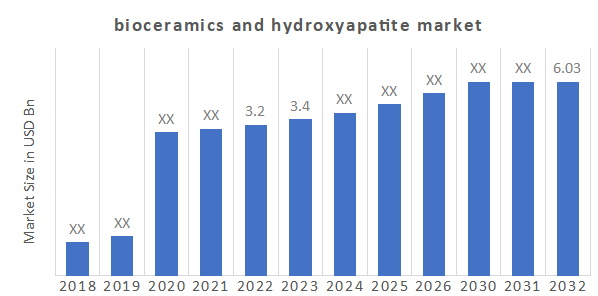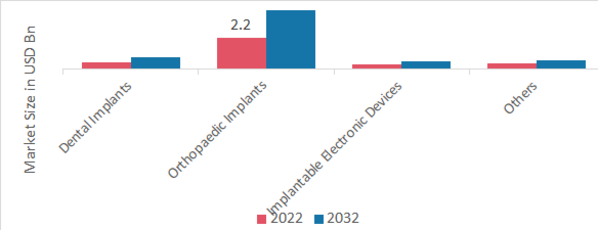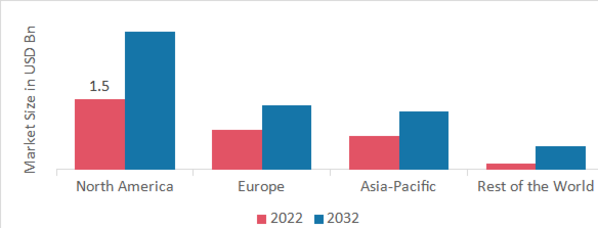Global Bioceramics and Hydroxyapatite Market Overview
Bioceramics and Hydroxyapatite Market Size was valued at USD 3.2 Billion in 2022. The Bioceramics and hydroxyapatite market industry is projected to grow from USD 3.4 Billion in 2023 to USD 6.03 Billion by 2032, exhibiting a compound annual growth rate (CAGR) of 7.30% during the forecast period (2023 - 2032).Advancements in material science, customization and 3D printing, increasing demand for dental and orthopedic implants, trends in tissue engineering, environmental concerns, are the key market drivers enhancing the market growth.

Source: Secondary Research, Primary Research, MRFR Database and Analyst Review
Bioceramics and Hydroxyapatite Market Trends
- Customization and 3D printing is driving the market growth
The bioceramics and hydroxyapatite markets are reaching new levels of innovation and application thanks in large part to customization and 3D printing. Particularly in the context of bioceramics and hydroxyapatite-based products, this dynamic combination of technologies has completely changed how medical implants and devices are developed, produced, and used. The biocompatibility of bioceramics and the accuracy of 3D printing have combined to create a new era of patient-centric healthcare solutions that provide unmatched advantages and potential.
With remarkable accuracy, 3D printing, sometimes referred to as additive manufacturing, enables the production of complex and highly personalized structures. This technology permits the creation of implants, scaffolds, and medical devices that are specifically matched to the anatomical requirements of a given patient using bioceramics and hydroxyapatite. In contrast to conventional manufacturing processes, which can need a great deal of manual effort and machining, 3D printing turn’s computer plans into actual products layer by layer. This is ideal for medical applications where time is frequently of the essence because it not only minimizes waste but also speeds up the production process.
The combination of bioceramics, hydroxyapatite, and 3D printing raises the bar for customization. Implants that are ideally matched to a patient's individual anatomy lessen pain, improve post-operative results, and lower the chance of problems. Additionally, this method is especially useful for complicated surgeries where off-the-shelf implants might not fit perfectly. Medical practitioners can create implants that completely blend with a patient's existing bone structure using 3D scans of the patient's body, improving functionality and quality of life.
The inclusion of complex internal features and porous topologies into bioceramic and hydroxyapatite implants by 3D printing goes beyond anatomical customisation. The porosity of natural bone can be mimicked by these structures, enabling the ingrowth of live tissue and accelerating integration. For instance, implants can be made in the field of orthopedics with porous surfaces that allow bone cells to grow into the implant, increasing fixation and stability.
The development of regenerative medicine is also aided by the fusion of customisation and 3D printing. The creation of bioceramic scaffolds that can be implanted in patients and act as a framework for tissue regeneration is being studied by researchers and medical professionals. These 3D-printed scaffolds serve as a template for cells to develop, differentiating and forming new tissue. This method has a lot of potential for uses including bone healing and organ transplantation. Thus, driving the Bioceramics and hydroxyapatite market revenue.
Bioceramics and Hydroxyapatite Market Segment Insights
Bioceramics and Hydroxyapatite Type Insights
The Bioceramics and hydroxyapatite market segmentation, based on type, includes aluminium oxide, zirconia, calcium phosphate and others. The aluminium oxide segment dominated the market in 2022. One prominent application of aluminum oxide's biocompatibility is in dental implants. To replace lost teeth, these implants are surgically inserted into the jawbone. Due to its biocompatibility, aluminum oxide-based ceramics are frequently employed for the implant's crown part. This makes it possible for the implant to successfully integrate with the surrounding bone tissue without triggering any negative reactions.
Bioceramics and Hydroxyapatite Application Insights
The Bioceramics and hydroxyapatite market segmentation, based on application, includes dental implants, orthopaedic implants, implantable electronic devices and others. The orthopaedic implants category generated the most income in 2022. Due to their biocompatibility, hydroxyapatite and bioceramics make great materials for orthopedic implants. For instance, the metal in a titanium alloy hip replacement implant may cause discomfort or even allergic reactions in the patient. A hip implant composed of bioceramic materials, on the other hand, would be far more biocompatible and less likely to result in negative side effects.
Figure 1: Bioceramics and Hydroxyapatite Market, by application, 2022 & 2032 (USD Billion)

Source: Secondary Research, Primary Research, MRFR Database and Analyst Review
Bioceramics and Hydroxyapatite Regional Insights
By region, the study provides the market insights into North America, Europe, Asia-Pacific and Rest of the World. The North America Bioceramics and Hydroxyapatite Market dominated this market in 2022 (45.80%). An aged person in the United States who has severe osteoarthritis in their knee may choose to have a total knee replacement. Due to the sophisticated healthcare system, people have access to cutting-edge orthopedic facilities and a variety of implant options. The best choice is bioceramic knee implants because of their long lifespan and biocompatibility. The sophisticated infrastructure and accessibility of cutting-edge implant materials help this patient. Further, the U.S. Bioceramics and hydroxyapatite market held the largest market share, and the Canada Bioceramics and hydroxyapatite market was the fastest growing market in the North America region.
Further, the major countries studied in the market report are The U.S., Canada, German, France, the UK, Italy, Spain, China, Japan, India, Australia, South Korea, and Brazil.
Figure 2: BIOCERAMICS AND HYDROXYAPATITE MARKET SHARE BY REGION 2022 (USD Billion)

Source: Secondary Research, Primary Research, MRFR Database and Analyst Review
Europe Bioceramics and hydroxyapatite market accounts for the second-largest market share. There are effective healthcare reimbursement systems in several European nations. Patients now have easier access to cutting-edge medical procedures, such as orthopedic implants, without having to shoulder the full financial load. In some instances, patients and medical professionals are encouraged to select bioceramic and hydroxyapatite implants because reimbursement is possible. Further, the German Bioceramics and hydroxyapatite market held the largest market share, and the UK Bioceramics and hydroxyapatite market was the fastest growing market in the European region.
The Asia-Pacific Bioceramics and Hydroxyapatite Market is expected to grow at the fastest CAGR from 2023 to 2032. An active middle-class person in this region who has been diagnosed with a hip fracture may decide to get a hip implant. Spending on healthcare has surged due to the region’s growing middle class, and people are increasingly looking for cutting-edge orthopedic treatments. Despite being more expensive, a bioceramic hip implant is viewed as a worthwhile long-term investment for a more active and pain-free life. Moreover, China’s Bioceramics and hydroxyapatite market held the largest market share, and the Indian Bioceramics and hydroxyapatite market was the fastest growing market in the Asia-Pacific region.
Bioceramics and Hydroxyapatite Key Market Players & Competitive Insights
Leading market players are investing heavily in research and development in order to expand their product lines, which will help the Bioceramics and hydroxyapatite market, grow even more. Market participants are also undertaking a variety of strategic activities to expand their footprint, with important market developments including new product launches, contractual agreements, mergers and acquisitions, higher investments, and collaboration with other organizations. To expand and survive in a more competitive and rising market climate, Bioceramics and hydroxyapatite industry must offer cost-effective items.
Manufacturing locally to minimize operational costs is one of the key business tactics used by manufacturers in the Bioceramics and hydroxyapatite industry to benefit clients and increase the market sector. In recent years, the Bioceramics and hydroxyapatite industry has offered some of the most significant advantages to medicine. Major players in the Bioceramics and hydroxyapatite market, including GE Healthcare, Bio-Rad, SofSera, ALB Technology Limited, Cam Bioceramics, Bonesupport AB, Fluidinova, Sigma Graft and others, are attempting to increase market demand by investing in research and development operations.
GE HealthCare Technologies Inc. (GE HealthCare) is a leading provider of medical devices, specializing in the design, development, production, and distribution of diagnostic imaging, clinical systems, drug discovery, biopharmaceutical production, cellular technologies, imaging agents for use in medical scanning, and a variety of healthcare IT products. Additionally, GE HealthCare offers services including computerized data management, performance enhancement and performance solutions, and remote diagnosis and repair services for medical devices made by the business and others. The corporation uses subsidiaries and affiliates to run its operations all over the world. Chicago, Illinois, in the US, serves as the headquarters of GE HealthCare.
Injectable bioceramic bone graft substitutes are developed, manufactured, and sold by BoneSupport AB (BoneSupport), a division of Bonesupport Holding AB, to treat fragility fractures brought on by osteoporosis as well as bone voids and gaps caused by trauma, illness, or surgical procedures. The company manufactures its bone graft substitutes using its patented technical platform CERAMENT. Among its key products are synthetic bone substitutes that release vancomycin and bone void fillers. Additionally, BoneSupport evaluates a variety of prospective pre-clinical product candidates for supporting bone development. The company uses a network of distributors to market its products in North America and Europe. BoneSupport's corporate headquarters are in Lund, Sweden.
Key Companies in the Bioceramics and Hydroxyapatite Market include
-
GE Healthcare
-
Bio-Rad
-
SofSera
-
ALB Technology Limited
-
Cam Bioceramics
-
Bonesupport AB
-
Fluidinova
-
Sigma Graft
Bioceramics and Hydroxyapatite Industry Developments
June 2023:GE Healthcare entered into a distribution agreement with DePuy Synthes to bring GE HealthCare’s OEC 3D Imaging System to more surgeons and patients across the US.
April 2023:FKG Dentaire increased their endodontic obturation portfolio in the European Union (EU), Israel, and the United Kingdom by adding additional bioceramic products, BC Universal RRM and BC Universal Sealer.
Bioceramics and Hydroxyapatite Market Segmentation
Bioceramics and Hydroxyapatite Type Outlook
-
Aluminium Oxide
-
Zirconia
-
Calcium Phosphate
-
Others
Bioceramics and Hydroxyapatite Application Outlook
Bioceramics and Hydroxyapatite Regional Outlook
-
Germany
-
France
-
UK
-
Italy
-
Spain
-
Rest of Europe
-
Asia-Pacific
-
China
-
Japan
-
India
-
Australia
-
South Korea
-
Australia
-
Rest of Asia-Pacific
-
Rest of the World
-
Middle East
-
Africa
-
Latin America
| Report Attribute/Metric |
Details |
| Market Size 2022 |
USD 3.2 Billion |
| Market Size 2023 |
USD 3.4 Billion |
| Market Size 2032 |
USD 6.03 Billion |
| Compound Annual Growth Rate (CAGR) |
7.30% (2023-2032) |
| Base Year |
2022 |
| Market Forecast Period |
2023-2032 |
| Historical Data |
2018- 2022 |
| Market Forecast Units |
Value (USD Billion) |
| Report Coverage |
Revenue Forecast, Market Competitive Landscape, Growth Factors, and Trends |
| Segments Covered |
Type, Application, and Region |
| Geographies Covered |
North America, Europe, Asia Pacific, and the Rest of the World |
| Countries Covered |
The U.S., Canada, German, France, UK, Italy, Spain, China, Japan, India, Australia, South Korea, and Brazil |
| Key Companies Profiled |
GE Healthcare, Bio-Rad, SofSera, ALB Technology Limited, Cam Bioceramics, Bonesupport AB, Fluidinova, Sigma Graft. |
| Key Market Opportunities |
R & D operations with reduces the cost of materials. |
| Key Market Dynamics |
The increasing competition in markets with rapid technological advancements. |
Bioceramics and Hydroxyapatite Market Highlights:
Frequently Asked Questions (FAQ) :
The Bioceramics and hydroxyapatite market size was valued at USD 3.2 Billion in 2022.
The market is projected to grow at a CAGR of 7.30% during the forecast period, 2023-2032.
North America had the largest share in the market
The key players in the market are GE Healthcare, Bio-Rad, SofSera, ALB Technology Limited, Cam Bioceramics, Bonesupport AB, Fluidinova, and Sigma Graft.
The Aluminium Oxide category dominated the market in 2022.
The Orthopaedic Implants had the largest share in the market.





























